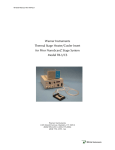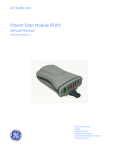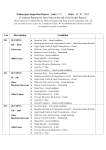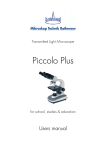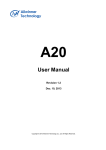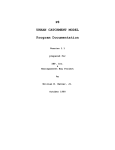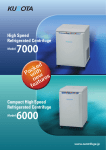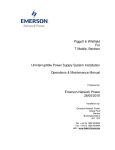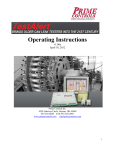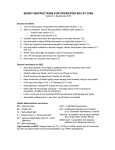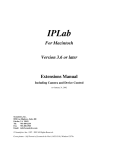Download Micro-Incubator Model CSMI User`s Manual
Transcript
Micro-Incubator Model CSMI User’s Manual Model CSMI Micro-Incubator MAI 65-0101 MA1 65-0102 Publication 5403-002 Revision A WEEE/RoHS Compliance Statement EU Directives WEEE and RoHS To Our Valued Customers: We are committed to being a good corporate citizen. As part of that commitment, we strive to maintain an environmentally conscious manufacturing operation. The European Union (EU) has enacted two Directives, the first on product recycling (Waste Electrical and Electronic Equipment, WEEE) and the second limiting the use of certain substances (Restriction on the use of Hazardous Substances, RoHS). Over time, these Directives will be implemented in the national laws of each EU Member State. Once the final national regulations have been put into place, recycling will be offered for our products which are within the scope of the WEEE Directive. Products falling under the scope of the WEEE Directive available for sale after August 13, 2005 will be identified with a “wheelie bin” symbol. Two Categories of products covered by the WEEE Directive are currently exempt from the RoHS Directive – Category 8, medical devices (with the exception of implanted or infected products) and Category 9, monitoring and control instruments. Most of our products fall into either Category 8 or 9 and are currently exempt from the RoHS Directive. We will continue to monitor the application of the RoHS Directive to its products and will comply with any changes as they apply. • Do Not Dispose Product with Municipal Waste. • Special Collection/Disposal Required. Table of Contents Harvard Apparatus Model CSMI Micro-Incubator 1 SUBJECT PAGE NO. General Information - Warranty and Repairs ........2 Specifications............................................................3 Introduction ..............................................................4 Principle Of Operation..............................................5 Supplied and Optional Accessories ....................6-7 Mounting the CSMI on a Microscope Stage ....8-10 Installation Disposable Chambers in CSMI ........11 Hookup and Operation ....................................12-15 Maintenance ......................................................16-17 Troubleshooting ......................................................18 Appendix 1: Typical Performance Curve ..............19 General Information Harvard Apparatus Model CSMI Micro-Incubator 2 Serial Numbers All inquires concerning our product should refer to the serial number of the unit. Serial numbers are located on the rear of the chassis. Calibrations All electrical apparatus is calibrated at rated voltage and frequency. While the flow will stay calibrated, the peak will vary. Warranty Harvard Apparatus warranties this instrument for a period of two years from date of purchase. At its option, Harvard Apparatus will repair or replace the unit if it is found to be defective as to workmanship or material. This warranty does not extend to damage resulting from misuse, neglect or abuse, normal wear and tear, or accident. This warranty extends only to the original customer purchaser. IN NO EVENT SHALL HARVARD APPARATUS BE LIABLE FOR INCIDENTAL OR CONSEQUENTIAL DAMAGES. Some states do not allow exclusion or limitation of incidental or consequential damages so the above limitation or exclusion may not apply to you. THERE ARE NO IMPLIED WARRANTIES OF MERCHANTABILITY, OR FITNESS FOR A PARTICULAR USE, OR OF ANY OTHER NATURE. Some states do not allow this limitation on an implied warranty, so the above limitation may not apply to you. If a defect arises within the two-year warranty period, promptly contact Harvard Apparatus, Inc. 84 October Hill Road, Building 7, Holliston, Massachusetts 017461388 using our toll free number 1-800-272-2775. Goods will not be accepted for return unless an RMA (returned materials authorization) number has been issued by our customer service department. The customer is responsible for shipping charges. Please allow a reasonable period of time for completion of repairs, replacement and return. If the unit is replaced, the replacement unit is covered only for the remainder of the original warranty period dating from the purchase of the original device. This warranty gives you specific rights, and you may also have other rights which vary from state to state. Repair Facilities and Parts Harvard Apparatus stocks replacement and repair parts. When ordering, please describe parts as completely as possible, preferably using our part numbers. If practical, enclose a sample or drawing. We offer a complete reconditioning service. CAUTION This pump is not registered with the FDA and is not for clinical use on human patients. Specifications Harvard Apparatus Model CSMI Micro-Incubator 3 Specifications: Model CSMI Micro-Incubator Temperature Operating Range With Supplementary Water Cooling 5°C to 50°C Without Supplementary Water Cooling 5° to 10° below ambient to 50°C Disposable Chambers Accommodated Nalge Nunc chambered slides chambered cover slips Bekton Dikinson chambered slides Microscopes Accommodated Zeiss Axiovert with attachable mechanical stage Leica DAS Mikroskop DMIL and DMIRB/E w/ attach. mech. stage. Nikon Diaphot, TE200, TE300 series rectangle stage Olympus IX50/70 or IMT-s fixed stage Peltier TED Current Rating 6 A DC Maximum Plate Thermistor: (Built in) 100 k at 25°C - YSI 44011 Perfusion Inlet Lines 26 GA Teflon capillary up to 4 lines can be installed simultaneously Perfusion Rate 3 ml/minute nominal total Perfusate Outlet LU-ASP aspirator Gas Port 1/16" barb Gas Superfusion Rate 0.5 to 2.0 L/min Weight 0.5 kg (17.9 oz) Overall Dimensions 6.5" x 4" x 1" CSMI Cable Plug Pin Assignment 1. Peltier 2. Peltier 3. Plate Thermistor 3 2 5. Peltier 4 6 4. Peltier 1 5 6. Plate Thermistor Ground Shield Introduction Harvard Apparatus Model CSMI Micro-Incubator 4 The CSMI is a versatile Microscope StageIncubator for cell/tissue culture work, which accommodates new rectangular disposable Chambered slides and Chambered cover glass available from Nalge Nunc, and Beckton Dickinson. The CSMI in combination with a matching low noise TC202A temperature controller facilitates long term maintenance of tissue or cell cultures on a microscope stage. This allows extended time optical monitoring including the use of dyes, microinjection, electrical recording and micromanipulation. The CSMI not only facilitates the precise regulation and manipulation of bath temperature, but also supports multi-channel perfusion and gas atmosphere maintenance, such as CO2 superfusion for pH control. Based on a successful Medical Systems Micro-incubator design for 35 mm Petrie dishes, the PDMI-2, the CSMI utilizes Peltier Thermo-Electric Devices to regulate temperature over a wide range both above and below ambient levels. The CSMI is designed to fit on the stage of inverted microscopes from nearly all-major microscope manufacturers including Zeiss, Nikon, Olympus and Leica Nalge Nunc Chambered Slide Nalge Nunc Chambered Slide Nalge Nunc Chambered Slide CSMI with Nalge Nunc Chambered Slide, Nalge Nunc Chambered Coverglass & Beckton Dickinson Chambered Slice Nalge Nunc Chambered Slide Principle of Operations Harvard Apparatus Model CSMI Micro-Incubator 5 The CSMI is composed of two metal plates a finned “Radiator” plate and a “Driven” plate between which are sandwiched Thermo-Electric Devices (TED’s) or Peltier heat pumps. The disposable chambered slide or chambered cover glass is placed by the user within temperature regulated clamps attached to the “Driven” plate. The TED’s pump heat from the radiator to the “Driven” plate for heating and from the “Driven” plate to the radiator for cooling. The “direction” of the heat pumping action is determined by the direction of DC electric current delivered to the TED’s. Through the use of a temperature sensor mounted on the “Driven “ plate and an external temperature controller (TC202A) that uses feedback control, precise temperature regulation can be achieved both above and below ambient temperature. If perfusion is required, two 26 GA Teflon perfusion lines can be mounted in each of the L shaped temperature driven claps. A separate aspirator is used to maintain fluid level irrespective of perfusate flow rate. Gas for superfusion over the chamber is delivered to a white 1/16th in barb port also attached to each L clamp. The exit for the gas is a narrow opening on the inner long surface of each L clamp facing the installed chamber. Having the perfusion lines and superfusion gas fed through the temperature regulated L clamps assures that fluid and gas delivered to the chamber are pre-temperature regulated before they arrive in the tissue culture dish. Diagram of CSMI parts Supplied and Optional Accessories Harvard Apparatus Model CSMI Micro-Incubator 6 The CSMI chamber depicted above is a flexible system that can be used in several modes of operation. These include perfused and static modes, with or without gas superfusion, with a bath thermistor or without and of course mounted on different microscope stages. The CSMI is shipped with the most commonly used accessories, which are packed separately and identified below. Supplied Accessories Catalog No. Description 65-0047 Leiden Aspirator on magnetic base LU-ASP for media removal during perfusion 65-0055 Bath Thermistor holder on magnetic base 7501-121 A set of two 4’ lengths of 1/8" ID Tygon tubing for gas superfusion 7501-122 A set of two 4’ lengths of 1/8" ID Tygon tubing with compler for 26 GA Teflon perfusion tubing for perfusion 7501-123 A 4’ length of 1/16" Tygon tubing for use with the Leiden Aspirator Supplied and Optional Accessories Harvard Apparatus Model CSMI Micro-Incubator 7 7501-124 One spare set of two 26 GA Teflon perfusion lines molded into proper shape for easy insertion in temperature driven clamps 7501-125 Two set of spare Thermo-conductive self adhesive elastomer pads to line the inner contacting surface of the L shaped clamps. 7501-126 Clear plastic cover with magnetic hold down frame. 7501-127 A set of 4 nylon set-screws for use when mounting on Nikon or Olympus inverted microscopes. Optional Accessories 65-0103 A copper water tube shaped to fit the slots in the CSMI radiator fins is available for applications where bath termperatures apporaching 0˚ C are required. In this case running tap water in the installed copper tube is used to improve the efficiency of heat removal from the CSMI in order to achieve this lower temperature range. 7501-127 Replacement tubing and Pad Kit containing all tubing and thermo Mounting the CSMI on a Microscope Stage Harvard Apparatus Model CSMI Micro-Incubator 8 The CSMI is equipped for easy mounting on microscope stages of several of the most popular inverted microscopes. There are two major considerations when installing the CSMI first is mechanical attachment to the stage and second is heat transfer between the CSMI and the microscope stage. Mechanical fixation is desirable because X-Y translation of the specimen can then be done using the microscope built in stage movement mechanism. In addition when the CSMI is mounted on a microscope stage, the stage which is generally made of material like aluminum serves as a low Thermo resistance pathway to conduct heat to or away from the CSMI. . In general when the CSMI is placed on a flat microscope stage, it is the Radiator portion that comes in contact with the stage. The “Driven” (temperature regulated) plate that holds the specimen is recessed slightly and does not come in contact with a flat stage. Specimen cooling performance of the CSMI is improved by extra heat removal through the microscope stage. Specimen heating performance is less affected by mounting considerations The following table describes how to mount the CSMI on various brands of Inverted Microscope. Brand Description Zeiss The CSMI is designed to fit directly into the holding clips of the Attachable Mechanical Stage available with Ziess inverted microscopes with the "M type" Mechanical Stage. For "K type"(3 Plates Stage), CSMI will need to be modified. Call Harvard Apparatus. Leica Inverted microscopes. The CSMI is designed to fit directly into the holding clips of the Attachable Mechanical Stage available with Leica inverted microscopes Mounting the CSMI on a Microscope Stage Harvard Apparatus Model CSMI Micro-Incubator 9 Note: The micro-incubator CSMI Cat# 65-0102 has the same construction as the regular CSMI Cat# 65-0101, with the difference that the bottom plate of the 65-0102, has been designed to be used in the following microscopes: ZEISS and LEITZ with 3-Plate mechanical Stage (known as “K” type) LUDL and PRIOR motorized stage in inverted microscopes. The 65-0102 will fit on the microscope stage with the dimensions of 160mm x 110mm. Both CSMI Cat# 65-0101 and the 65-0102 can be used on microscope stages with “FLAT” surface and with a round opening between: 88 mm to 110 mm. To avoid vibration (if any), modeling clay or dentist wax could be applied at the edge of the micro-incubator. Microscope stage “M” Type 65-0101 Mounting frame M for specimen slider 76 x 26 mm Object guide 130 x 85 mm right Object guide 130 x 85 mm left Microscope stage “K” Type 65-0102 Specimen stage 250 x 230 mm Mounting frame K for specimen slider Mounting frame K for reflected light, d=72 mm Stage stop d=28 mm Stage stop d=35 mm Stage stop d=18 mm (further stage stops being prepared) Mechanical stage 130 x 85 R/L without mounting frames Gliding stage Z with stage inserts d=24 mm and 48 mm Mounting the CSMI on a Microscope Stage Harvard Apparatus Model CSMI Micro-Incubator 10 Nikon Nikon inverted microscopes have a stage opening that is 108 mm in diameter. The CSMI is mounted over this opening using four nylon set screws inserted into four tapped holes located on an 108 mm diameter in the bottom of the CSMI. The setscrews protrude into the edges of this opening, locking the CSMI to the stage for X-Y translation. Olympus Olympus inverted microscopes have a stage opening that is 80 mm in diameter. The CSMI is mounted over this opening using four nylon set screws inserted into four tapped holes located on an 80 mm diameter in the bottom of the CSMI. The setscrews protrude into the edges of this opening, locking the CSMI to the stage for X-Y translation. Other For microscopes not mentioned above, contact Harvard Apparatus Inc. technical support to discuss mounting options. Please Note Though CSMI can be rested and operated on a microscope stage surface. Care must be taken that only the finned “Radiator “ plate comes in contact with the stage. The temperature controlled “Driven “ plate must not touch any part of the microscope. Installation of Disposable Chambers in CSMI Harvard Apparatus Model CSMI Micro-Incubator 11 The CSMI is a finned rectangular assembly with two temperature controlled L shaped clamps inside. To install a disposable chambered slide or chambered cover slip refer to the drawing below: First open the two L shaped clamps fully by sliding them diagonally away from the center. Push on the knurled knobs at the corner of each clamp. Caution do not try to force the clamps in the X or Y direction they only slide diagonally. Once the Clamps are open, carefully insert the Chambered slide or chambered cover slip so that it rests on the metal strips in the opening. Note: care must be taken, that disposable chambers do not fall through the opening in the floor of the CSMI during installation, spilling their contents. This may be a problem on installation more so with Chambered cover slips which are shorter than Chambered slides. Once the disposable chamber rests on the floor of the CSMI, slide the L shaped clamps inward diagonally to the closed position with care so that the contents are not spilled. Make sure the clamps are firmly pressed against the sidewalls of the disposable chambered slide or cover slip. This is to insure good thermal contact between the clamps and the chamber wall for proper heat transfer and temperature control. The inner, chamber contacting surfaces of the clamps are equipped with a Thermo-conductive elastic lining. This lining is designed to mold itself around imperfections and high spots in the injection molded chamber walls, to prevent air gaps that might reduce heat transfer and performance. Hookup and Operation Harvard Apparatus Model CSMI Micro-Incubator 12 1. Connection to Temperature Controller (Please also refer to the TC202A Users manual for additional operating instruction) To prepare for operation the CSMI is connected to a TC202A temperature controller by plugging its cable end plug into the I/O socket on the TC202A front panel. The TC202A can sense CSMI “Driven” plate temperature through this cable, as well as supply power to the Peltier heat pumps. The TC202A also supports an optional second temperature sensor, the “Bath Thermistor” which can be inserted in the disposable chamber media to measure temperature therein. The “Bath “ Thermistor is not always used, if it is it has its own cable and plug and should be connected to the TC202A at this time. Drawing or photo of CSMI connection to TC202 2. Using the Plate or Bath Thermistor for temperature feedback and control During operation there generally is a difference in temperature between the temperature “Driven Plate” and the media in the disposable chambered slide (Bath). The gradient between Plate and the center of the Bath could be 1 to 4 (C depending on such factors as thermal resistance of the chamber wall, media depth, perfused or static operation, gas superfusion etc. The offset is positive or negative depending on whether one is heating or cooling. Though we always want to control temperature in the bath, often Plate control is the best solution. This is the case for example in situation where media sterility is required and the burden of sterilizing the bath thermistor makes it impractical. The Plate temperature can be offset manually to stabilize at a higher or lower temperature in order to compensate for any difference between bath and plate. Hookup and Operation Harvard Apparatus Model CSMI Micro-Incubator 13 For the most part the safest mode of operation is to use the Plate thermistor as the control point. Plate control has the advantage of not being subject to unintended “open loop “ operation, where temperature control is lost. This can occur accidentally with bath control, but is highly unlikely with plate control. A bath thermistor can become accidentally dislodged from the bath so that it no longer measures bath temperature. During extended operation media evaporation can uncover the bath thermistor-sensing tip, causing it to read incorrectly. In this case the temperature controller loses control. With plate control bath temperature can still be precisely monitored by a Bath thermistor but control will not be dependent on it. Plate control also has the advantage of bringing the system to the control point temperature faster than Bath control. The bath temperature lags the plate temperature. This lag causes the system to take longer for bath temperature to settle at the control set point. With the above caveats in mind, bath control has a major advantage over plate control. With the bath thermistor as the control point, the temperature controller automatically compensates for the temperature gradient between plate and bath and for changing environmental conditions including perfusion changes. Probably the best strategy is to quickly bring the bath to the target temperature using plate control. Then switch to bath control for the greatest precision in long term temperature maintenance. 3. Installation of optional Bath Thermistor The “Bath Thermistor” is inserted in the media and held in place using the supplied magnetic base thermistor holder which attaches to the ferrous (chrome plated) top surface of each L shaped clamp. If the plastic cover with magnetic frame is to be used over the chamber in conjunction with the Bath thermistor it can either be slid open partially to accommodate the thermistor. Alternatively a 1/8" hole can be drilled in the cover where the bath thermistor is to pass through. 4. Static operation For static or non-perfused operation, a chamber with media is installed and a set point is entered into the temperature controller. If 37 ( C is selected, it will take approximately 25 minutes for the temperature to stabilize starting from room temperature. At this higher temperature long term incubation will result in media loss through evaporation. Using mineral oil over aquious media can slow this. If mineral oil cannot be used, the clear plastic cover, which is supplied, can also reduce evaporation. Hookup and Operation 14 Harvard Apparatus Model CSMI Micro-Incubator 5. Perfused Operation Perfusion is a useful tool to study pharmaceutical effects both in applied and washout modes. To establish perfusion, perfusate is delivered to the chamber through 26GA. Teflon capillary tubing. Two such perfusion lines are installed in close fitting slots in the temperature controlled L clamps that surround the chamber. The perfusate supply, which can be kept at room temperature, is warmed or cooled by conduction before delivery into the chamber bath. The perfusate should be delivered at a rate of 1 to 3 ml/min. This is best accomplished by a peristaltic pump, like the Harvard Apparatus model ‘66’ catalog # 55-7766. A set of two 1/8" Tygon hoses with couplers for the 26 GA. Teflon capillaries are supplied, to make the connection to the peristaltic pump or other perfusion source. If perfusion is to be continuous than bath media must be removed to prevent overflow. A unique adjustable aspirator the LU-ASP catalog # 65-0047, is supplied which can automatically maintain a constant fluid level with minimal fluctuations in that level as it works (see adjacent drawing). Fluid level fluctuations not only can disturb optical measurements, but can also be a source of electrical noise, if sensitive Electro-physiologic recording such as patch clamping is done. . The aspirator has a magnetic base to grip the magnetic surface on each of the L clamps. The level of fluid in the chamber is determined by the height of the aspirator in the bath, and can be adjusted with its thumbscrew. A source of suction with a liquid trap is connected via the supplied 1/16 “ Tygon tubing. Because of the design of the aspirator the user can operate one or more perfusion lines simultaneously without further adjustment to the aspirator. During perfused operation media is replenished continuously and evaporation is not a problem until perfusion is halted. If perfusion is to be interrupted the plastic cover should be used to minimize evaporation. The plastic cover is supplied without any holes drilled. If it is to be used simultaneously with a LUASP aspirator, as is the case with a bath thermistor, the user can partially slide the cover back, or alternatively drill a hole to accommodate the aspirator. . The drawing below depicts the hookup for perfusion. Operating the temperature controller for perfusion is similar to operation in static mode. Because of feedback control the temperature controller will automatically adjust power delivered to the heat pumps to compensate for the additional load imposed by perfusion, irrespective of whether plate or bath control is used. Hookup and Operation 15 Harvard Apparatus Model CSMI Micro-Incubator 6. Gas superfusion Gas superfusion is often used to aid in pH balance (5% C02 ) as well as for improved oxygenation. The CSMI has provisions for delivering gas via a cavity in the temperature regulated L clamps to a slit just over the edge of the disposable chambered slide. This causes the gasses to be delivered to the chamber pre temperature regulated. Heavier than air gasses like C02 will then fall into the chamber cavity. With the aid of the supplied plastic cover a low-pressure atmosphere of any desired gas mixture can be maintained in the chamber. The gas is delivered from a tank equipped with a regulator and flowmeter, to the white barb fitting at the long end of the temperature regulated L clamp. A 1/8 “ Tygon hose is supplied for this purpose. Both L clamps have gas ports. These can be used simultaneously or separately for the same or different gasses. The drawing below depicts the hookup for gas superfusion. Operating the temperature controller with gas superfusion is similar to operation in static or perfused mode. Because of feedback control the temperature controller will automatically adjust power delivered to the heat pumps to compensate for the additional load imposed by gas superfusion, irrespective of whether plate or bath control is used. Gas superfusion can be done in conjunction with fluid perfusion as well as with static protocols. 7. Special considerations for cooling At room temperature the CSMI is more efficient in heating than cooling the disposable chambered slide. Although the CSMI can easily attain and hold any temperature between ambient and 50° C, it is limited to cooling to a range of 5 to 10° C below ambient depending on mounting particulars. This is due to the limited efficiency in heat removal afforded by the air radiating fins combined with the microscope stage. For users who want to cool to lower temperatures than this, an optional auxiliary copper water radiator tube is available that fits in a slot cut into the radiating fins. Running tap water in this auxiliary radiator improves cooling performance greatly so that single digit temperatures can be maintained. The Drawing below depicts the auxiliary radiator in place. Maintenance Harvard Apparatus Model CSMI Micro-Incubator 16 Perfusion tubing replacement: The installed Teflon capillary perfusion tubing can be used many times if kept clean. The perfusion lines should be flushed with distilled water after use to avoid cross contamination. Occasional perfusion of 70% alcohol will help avoid growth of microorganisms. Should replacement of perfusion tubing be required, a spare set of two lines is included with each CSMI. The perfusion tubing is preformed to the circuitous shape of the grooves into which it is to be installed, to makes it easier to install the rather stiff Teflon capillary. To obtain additional sets order. A set of Perfusion tubing shaped to fit into L clamps To replace the perfusion lines follow the steps 1-6, referring to the drawing of the temperature driven L clamp below. 1. Remove holding the chrome plated L clamp cover. 2. Remove the Chrome plated cover, and the black tubing cover resting inside to reveal the perfusion lines. 3. Note the way the perfusion lines are installed in their heat transfer slots. The two lines are not the same but are shaped differently to fit in different positions in the L clamp. 4. Lift and discard the installed tubing and replace with a new set. 5. Make certain that the tubing rests fully in the heat transfer groves, and install the black tubing cover. 6. Replace the Chrome cover and re-fasten with the two Phillips screws and 1 knurled knob removed earlier. Perfusion tubing installation drawing Perfusion tubing installation drawing Maintenance Harvard Apparatus Model CSMI Micro-Incubator 17 Replacement of elastic Thermo-conductive L clamp lining: Each L clamp is lined with flexible Thermo-conductive material, on all inner walls that come in contact with the disposable chamber. The lining is designed to conform to irregularities in the surface of the disposable chamber, as the L clamps close. Tight air-pocket free contact between the L clamps and the chamber is required to guarantee maximum heat transfer between the temperature driven L clamps and the disposable chamber. The lining can be used for many open and close cycles. Should it become damaged it can easily be replace by the user. A spare set of self-adhesive lining pads is packed with each system. To reorder use (Cat. # 7501-125) To replace: 1. Open the L Clamps to their full open position, and remove any chamber within. 2. Peel the existing lining pads off from the inner chamber wall. 3. Clean the surface that held the pads with alcohol (use Q-tip or equiv.) and let dry. 4. Remove the backing from the adhesive surface of a new lining pad and attach to the long surface of an L clamp. Position carefully so that the Gas inlet slit near the top of the L clamp is not blocked. 5. Repeat the procedure with a “short” lining pad. Troubleshooting Harvard Apparatus Model CSMI Micro-Incubator 18 The following table lists some problems, possible causes and remedies. This is not meant to be exhaustive, but as a checklist to allow the user to solve the more common occurrences. Many problems arise from improper use of the TC202A temperature controller. Please refer to the TC202A user’s manual if the problem you experience is not listed here. Problem Description 1. The bath temperature does not reach a heating set point. 1a. The L Clamps are not closed tightly around the chamber. -Check and fix. 1b. Static fluid level is too low-raise 1c. Perfusion rate is too high-lower below 3 ml/min 2. The bath temperature does not reach a cooling set point. 2a. The L Clamps are not closed tightly around the chamber. -Check and fix 2b. Static fluid level is too low-raise 2c. Perfusion rate is too high-lower below 3 ml/min 2d. Set-point is outside of working range without auxiliary water radiator- change setting or add auxiliary water radiator 3. Bath temperature is rising above ambient even though set-point is for cooling below ambient 3a. Set-point is outside of temperature working range without auxiliary water radiator- change setting or add auxiliary water radiator 4. Excessive 50/60 Hz. noise in 4a. CSMI ground not connected (through Electro-physiologic recording done from TC202A mains protective ground pin tissue in the chamber. in power cord) or connected to poor ground. - Plug TC202A into better grounded power outlet or into same outlet as recording equipment 4b. Remove bath thermistor if used, and use only plate thermistor and plate control 5. Bath temperature inaccurate or unchanging 5a. Replace bath thermistor Appendix 1: Typical Performance Curve Harvard Apparatus Model CSMI Micro-Incubator 19 The above performance curve was obtained using a Nunc chambered coverglass chamber. The bath chamber contained 2.5 ml of water under static conditions with a plastic cover slid back to accommodate the bath thermistor. The dark blue curve represents the set point entered into the TC202A temperature controller. The light blue curve is the temperature measured at the radiator fins.





















